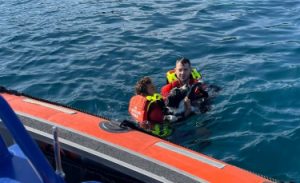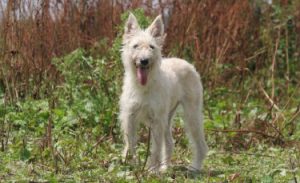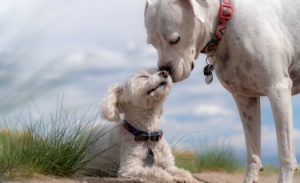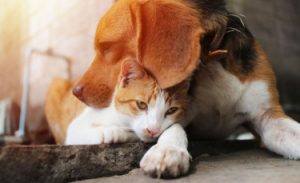Other names: Chesapeake Bay Retriever, Chessie
Courageous and determined, the Chesapeake Bay Retriever is armed to face difficult climatic conditions both mentally and physically. This medium to large sized dog is, in fact, endowed with a powerful and solid constitution, as well as a double coat giving him a very good protection against the cold and the humidity. In addition to its skills developed through a long history of waterfowl hunter / reporter, the Chesapeake Bay Retriever is an excellent companion for the whole family, including children with whom it is playful and energetic.
<!–
–>
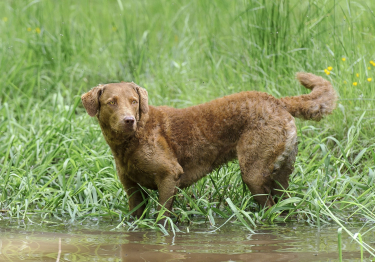
| Short | |
| United States | |
| Big | |
| Long |
| Sex | Weight | Cut |
|---|---|---|
| Female | From 25 kg to 32 kg | From 53 cm to 61 cm |
| Male | From 29 kg to 36 kg | From 58 cm to 66 cm |
History of the breed
A shipwreck in 1807 is believed to be the origin of the Chesapeake Bay Retriever breed. The ship in question came from Great Britain and had run aground off Maryland, in Chesapeake Bay (eastern United States). Among the survivors were a couple from Newfoundland: a male named Sailor and a female named Canton .
Both showed excellent swimming skills and waterfowl report, in particularly difficult conditions: cold water, layers of ice, tides, winds … to the point that local duck hunters began to to set up breedings by crossing these dogs with different reporters of waterfowl originating from the region or from other regions, to give litters of resistant, determined and enduring animals. The Curly Coat Retriever, the Flat-Coat Retriever and the Irish Water Dog are among the breeds involved in the development of the Chesapeake Bay Retriever.
Development continued throughout the 19th century, leading to the recognition of the breed by most major kennel clubs. The AKC (American Kennel Club) did so from its creation in 1884. The FCI (Fédération Cynologique Internationale) recognized it definitively in September 1964.
Chesapeake Bay Retriever Pictures

View all Chesapeake Bay Retriever photos from Woopets members
Physical features
His hair : tight and short. The outer coat is coarse and associated with a high density undercoat and a woolly texture, together providing the dog with effective protection against water and ice.
Its color : preferably single-colored, in all shades of brown, rush or dead grass. With or without a small white spot on the chest, abdomen, fingers or back of the feet.
His head : the skull is broad and rounded, the stop medium and the jaws powerful.
His ears : small, hanging, set high and with a moderately thick pavilion.
His eyes : light in color, ranging from yellowish to amber, moderately large and displaying an expression of intelligence and liveliness.
His body : moderately long and well proportioned. The back is short and powerful, the chest strong and broad.
Its tail : of medium thickness and length, straight or slightly curved, never rolled up on the back nor carried on the sides.
Behavior and character
| Affectionate | |
|---|---|
| Calm | |
| Protective | |
| Independent | |
| Hunter | |
| Barks / howls |
Behavior with others
| Cohabitation with children | |
|---|---|
| Sociable with other animals | |
| Love strangers |
Awake and intelligent, the Chesapeake Bay Retriever is a hard worker who loves to stay active, play, and please his owner. His joie de vivre is communicative and his affectionate character is expressed towards all his family, especially the children for whom he is an excellent playmate. The Chesapeake Bay Retriever also has a flair of great finesse and a protective instinct well marked, without being aggressive. He takes great pleasure in moving in the water. Outside of play sessions, outings and exercises, he knows how to stay calm and composed. His balanced temperament and his great capacity for adaptation make him a first-rate family companion.
The Chesapeake Bay Retriever
is it right for you? Take the test!
Education
| Clever | |
|---|---|
| Obedient |
Naturally focused on work and play, the The Chesapeake Bay Retriever is easily educated when exploiting these aspects by relying on patience and positive methods . Rewards and encouragement go a long way in making them an obedient dog. Just as important is a socialization process started early enough in life, as is learning to recall. The Chesapeake Bay Retriever, like all its congeners besides, should not undergo any form of brutality in its education.
Living conditions
| Suitable for apartment living | |
|---|---|
| Good for new masters | |
| Love it hot | |
| Love the cold |
The Chesapeake Bay Retriever is a very good family dog that adapts to all living conditions . However, he has a clear preference for environments close to nature : countryside, woods, water points, etc. He can adapt to city life if he is walked and stimulated enough. It would therefore be best for this dog to live in a house with a large fenced garden, rather than in an apartment.
Health
| Solid | |
|---|---|
| Ease of gaining weight |
The Chesapeake Bay Retriever is a healthy dog. Thanks to its dense and protective double coat, it is resistant to cold and bad weather . Its dress also allows it to dry quickly after moving in the water. There are, however, certain predispositions to disease in this breed. These are mainly hip and elbow dysplasias, certain eye damage (progressive retinal atrophy), exercise-induced collapse and degenerative myelopathy.
Hypoallergenic breed
No
Litter size
Between 7 and 9 puppies.
| Major concerns |
|
||
| Minor concerns |
|
| Occasional concerns |
|
|||||
| Suggested tests |
|
To protect yourself from these risks and insure your companion in case of health problems, Woopets recommends a Chesapeake Bay Retriever dog insurance .
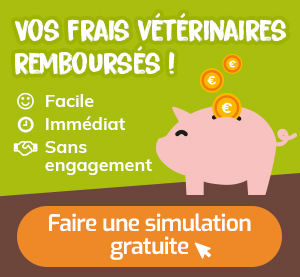
function showAssuranceForm () {var siteReferer = var id_race_association = ’98’; //console.log(id_race_association);success: function (html) {}});}document.addEventListener (‘DOMContentLoaded’, () => {$ (‘# assuranceModalBanner’). on (‘show.bs.modal’, function (event) {showAssuranceForm ();});});
Life expectancy
Minimum: 10 years
Maximum: 13 years
The life expectancy of a Chesapeake Bay Retriever is, on average, between 10 years and 13 years.
Calculate the Human Age of Your Chesapeake Bay Retriever!
To choose… 1 year 2 years 3 years Four years 5 years 6 years 7 years 8 years 9 years 10 years 11 years old 12 years 13 years 14 years old 15 years old 16 years old 17 years 18 years old 19 years old 20 years 21 years old
Maintenance and hygiene
| Ease of maintenance | |
|---|---|
| Cost of maintenance | |
| Hair loss |
| Drool level | |
|---|---|
| Ease of grooming |
Outside of moulting periods, when this dog can lose a lot of hair, the Chesapeake Bay Retriever does not require complex maintenance work .
A weekly brushing session is sufficient to maintain the beauty and health of the Chesapeake Bay Retriever’s coat and skin. During shedding, these treatments become more frequent to effectively manage hair loss. Baths should not be frequent so as not to alter the natural oily film that protects their coat and skin. Brushing teeth, inspecting and cleaning the eyes and the inside of the ears and pest control treatments are, of course, essential for his health and well-being. If they do not wear out naturally, its claws need to be cut. If you are new to this, it is recommended that you seek advice from a veterinarian or groomer.
Price and budget
Purchase price
Mini
800 € Maxi
1200 €
The purchase price of a Chesapeake Bay Retriever is between € 800 and € 1,200.
Annual maintenance cost
Mini
Max € 500
600 €
The annual maintenance cost of a Chesapeake Bay Retriever is between $ 500 and $ 600.
No name is currently proposed. Use our tool to find your Chesapeake Bay Retriever’s name!
Food
The first quality kibbles, rich in proteins and ensuring complete contributions (vitamins, minerals…), are recommended for this athletic dog that is the Chesapeake Bay Retriever. It is important to ensure that the quantities given to him remain reasonable and adapted to his real needs, in order to prevent any risk of overweight. The veterinarian is best placed to advise the master on this point.
Want the best for your dog?
Create the tailor-made diet for your Chesapeake Bay Retriever
I discover !
PROMO -30% | Delivered to you!

Physical activity
| Athletic | |
|---|---|
| Energy level | |
| Potential to play |
The Chesapeake Bay Retriever cannot be satisfied with short walks. It needs long and frequent outings , ideally in spaces where it can evolve without a leash in complete safety (hence the need to learn to recall). All complemented by games , especially those appealing to his natural instinct as a reporter dog: thrown, hidden objects …
Competitions
| Classifications & Standards |
|
Others
| Master character <span class="btnTooltip qTip2" title="- Calm: the master must be gentle and know how to show patience. – Active: the owner must be energetic and dynamic to live in harmony with his dog. – Hyperactive: the owner must be stimulating and very restless to suit the temperament of his dog.”> |
Active |
|---|
We talk on the forum
A little help on e-bay to help a young association …..
Guest message
Golden retriever
Adep message
Gorgeous Golden Retriever is looking for female to build a family!
Message from Aurelie78125
golden retriever … humor
Message from Joo
Flat coated retriever puppies
Message from Abreu Carlos
Have a question about the Chesapeake Bay Retriever?
Do not hesitate to ask Woopets visitors for advice on the forum!
FCI Information
FCI No.
263
FCI Group
Group 8: Retrieving game dogs – Game-raising dogs – Water dogs
Recognized by FCI
Since 1964
</div


